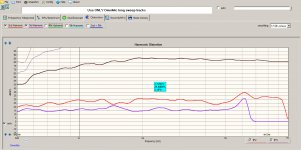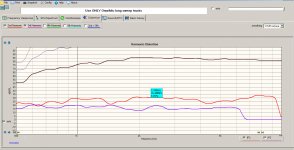Prove it with measurement.
First prove is an impossibility, and given the significant limirtaions of what we can measure with instruments, we have a ways to go before we even get close.
To quote Floyd Toole:
Two ears and a brain are massively more analytical and adaptable than an omnidirectional microphone and an analyzer.
dave
What am I
Who is Floyd Toole??? A guru ?
"The human sensory system is open to emotional response and should play no part in the design process" David Purton..... Design ~ Create ~ Listen should be the order?
I have retaken the distortion plots as some seem unsatisfied by the results originally posted. The new plots below were taken at 1m and a level of 85dB. For the whole loudspeaker with music as programme, you could probably expect levels around 10dB higher.
As before, no EQ but the total system was "in circuit"..CD - DAC - KT EQPT1 valve EQ - TL Audio parametric - Rane 23 active X-over - Inter M power amps. The amp driving the horn has been tweaked by the service agent to increase the bias so the first watt is in class A. At 85dB/1m the amp will be dissipating around .07 watt into the horn! The whole loudspeaker has a sensitivity of around 97dB/watt with controlled directivity above 1kHz, 3 way active. Unlike a coaxial design, the horn limits its vertical dispersion to around 40 degrees and is therefore less influenced by ceiling/floor reflections. The consistent 90 degrees horizontal dispersion all the way to 10kHz provides excellent imaging qualities. All the usual prescribed horn benefits of controlled dispersion providing even power delivery throughout the listening area...
A word about 2nd HD. It's mostly inaudible! Like valve amps, horns predominantly produce increasing 2nd order HD with increasing power. This will add a little "complementary" warmth.
Odd harmonic should be kept to a minimum and frankly I can live with figures in the .0X area, particularly if they include the whole system distortion content.
Here they are....
Who is Floyd Toole??? A guru ?
"The human sensory system is open to emotional response and should play no part in the design process" David Purton..... Design ~ Create ~ Listen should be the order?
I have retaken the distortion plots as some seem unsatisfied by the results originally posted. The new plots below were taken at 1m and a level of 85dB. For the whole loudspeaker with music as programme, you could probably expect levels around 10dB higher.
As before, no EQ but the total system was "in circuit"..CD - DAC - KT EQPT1 valve EQ - TL Audio parametric - Rane 23 active X-over - Inter M power amps. The amp driving the horn has been tweaked by the service agent to increase the bias so the first watt is in class A. At 85dB/1m the amp will be dissipating around .07 watt into the horn! The whole loudspeaker has a sensitivity of around 97dB/watt with controlled directivity above 1kHz, 3 way active. Unlike a coaxial design, the horn limits its vertical dispersion to around 40 degrees and is therefore less influenced by ceiling/floor reflections. The consistent 90 degrees horizontal dispersion all the way to 10kHz provides excellent imaging qualities. All the usual prescribed horn benefits of controlled dispersion providing even power delivery throughout the listening area...
A word about 2nd HD. It's mostly inaudible! Like valve amps, horns predominantly produce increasing 2nd order HD with increasing power. This will add a little "complementary" warmth.
Odd harmonic should be kept to a minimum and frankly I can live with figures in the .0X area, particularly if they include the whole system distortion content.
Here they are....
Attachments
Beyond the scope of Omni Mic 5.2. You need to refer back to the original plots and the recent HD ones posted here..
We are looking at just the horn/driver of course. The HD distortion plots reveal a relatively consistent result across the whole bandwidth and the BD and CS display display good behaviour with some anomolies above 10kHz.
No loudspeaker is perfect, nor ever can be despite marketing claims. I met my goal of creating the horn and driver to look like a 6 ohm resister throughout to ensure constant damping.
Part of the exercise was to prove these design goals can be met with "real world" product. As you know the horn itself is "off the shelf" at around £30 each..the Beyma is good value in the UK (for now) but relatively expensive in the US, but nowhere near TAD territory.
It's priorities and comparing like for like..a horn has certain attributes, constant directivity and efficiency being just two, but they have compromises..like electrostatics, ribbons, panels, moving coil..like I said nothing is perfect, but I am now as comfortable listening to the 3 way active "monitors" in their listening space as I am my Stax headphones. And if you rate speakers by real world dynamics capable of life size imaging without harshness and not tied to one listening seat....
I will investigate further if I can achieve IMD plots but I suspect they will be of limited value given the excursion of a CD diaghram is negligible anyway...
We are looking at just the horn/driver of course. The HD distortion plots reveal a relatively consistent result across the whole bandwidth and the BD and CS display display good behaviour with some anomolies above 10kHz.
No loudspeaker is perfect, nor ever can be despite marketing claims. I met my goal of creating the horn and driver to look like a 6 ohm resister throughout to ensure constant damping.
Part of the exercise was to prove these design goals can be met with "real world" product. As you know the horn itself is "off the shelf" at around £30 each..the Beyma is good value in the UK (for now) but relatively expensive in the US, but nowhere near TAD territory.
It's priorities and comparing like for like..a horn has certain attributes, constant directivity and efficiency being just two, but they have compromises..like electrostatics, ribbons, panels, moving coil..like I said nothing is perfect, but I am now as comfortable listening to the 3 way active "monitors" in their listening space as I am my Stax headphones. And if you rate speakers by real world dynamics capable of life size imaging without harshness and not tied to one listening seat....
I will investigate further if I can achieve IMD plots but I suspect they will be of limited value given the excursion of a CD diaghram is negligible anyway...
IIRC Earl Geddes found that the non-linearities that cause HD in a driver don't cause corresponding IMD as they do in an amplifier due to the driver effectively damping them, both mechanically and electrically. It would be interesting to see if a horn functions differently, I'm sure he and others already know the answer.
What am I
Here's something to get your head around. Reassuring that manufacturers such as Beyma rely on science in their research and have a deep understanding of the products they make. Bit of a side swipe at the BMS Coaxial??!!
https://www.beyma.com/wp-content/up...d-other-distortions-in-compresion-drivers.pdf
But mostly above my pay grade!!
Earl Geddes has retired now, sadly!
Here's something to get your head around. Reassuring that manufacturers such as Beyma rely on science in their research and have a deep understanding of the products they make. Bit of a side swipe at the BMS Coaxial??!!
https://www.beyma.com/wp-content/up...d-other-distortions-in-compresion-drivers.pdf
But mostly above my pay grade!!
Earl Geddes has retired now, sadly!
Last edited:

